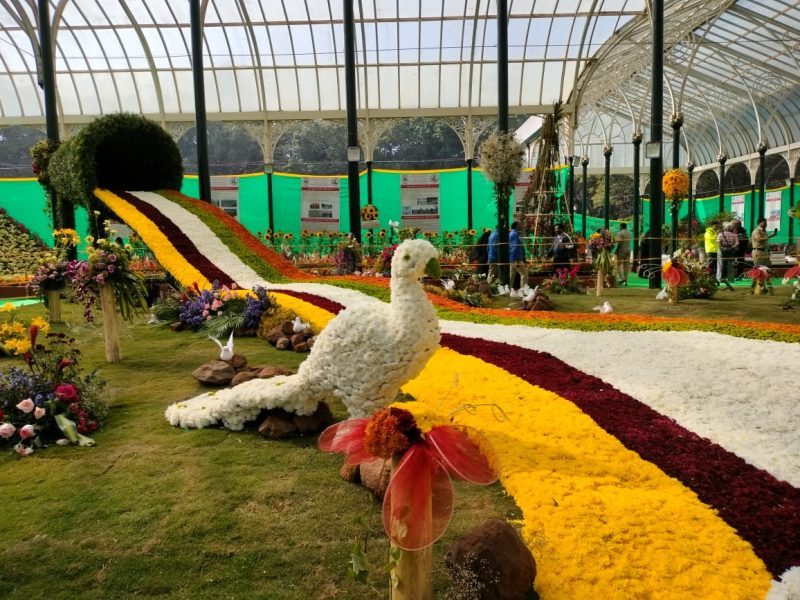
Rediscovering Lalbagh at Bengaluru's spectacular flower show
Besides the spectacular flower show, Lalbagh garden itself, situated in the heart of the tech city, and largely ignored by its busy residents, teems with fascinating stories from the past. One such story is that of the German landscape gardener, GH Krumbiegal

Bengaluru’s spectacular bi-annual Flower Show held at the over 250-year-old Lalbagh and which took shape sometime in the 1900s, was a tradition established by the European superintendents of the garden.
While some experts on the city’s history give the credit to John Cameron, a botanist and curator of Lalbagh in 1874, for flagging off Bengaluru’s famous signature flower show, it is GH Krumbiegel, superintendent from 1908, who made it a regular event and popularised it. He was probably inspired by the Chelsea flower show in the UK, which is supposed to be a major event in the British high society calendar.
Also watch: What’s new this Republic Day — from Central Vista to Agniveers
Incidentally, Cameron is the one who proposed the historic Glass House in Lalbagh, in which the main part of the Lalbagh flower shows are held each year. The Glass House is actually modelled on the The Crystal Palace in London built of cast-iron and plate-glass, and experts on the city say that tea parties were held inside once upon a time.
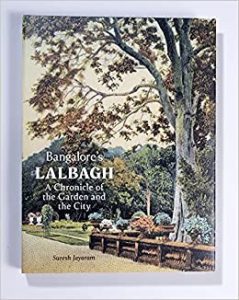 In his book, Bangalore’s Lalbagh, A Chronicle of the Garden and the City, artist and art historian Suresh Jayaram writes that in the past, prizes in the Lalbagh flower show were given across categories such as best foliage, perennials, annuals, cut flowers, and English fruits. And, in a bid to add variety and pique people’s interest further about the flower show, in 1869 and 1870, the organisers even included livestock, cattle, sheep, poultry and displays of horses of Mysore pedigree, writes Jayaram in his book.
In his book, Bangalore’s Lalbagh, A Chronicle of the Garden and the City, artist and art historian Suresh Jayaram writes that in the past, prizes in the Lalbagh flower show were given across categories such as best foliage, perennials, annuals, cut flowers, and English fruits. And, in a bid to add variety and pique people’s interest further about the flower show, in 1869 and 1870, the organisers even included livestock, cattle, sheep, poultry and displays of horses of Mysore pedigree, writes Jayaram in his book.
In fact, in 1912, GH Krumbiegel introduced a floral bicycle parade in which young girls including his own daughter Hilda dressed in all their finery cycled around with flower-bedecked bicycles, adds Jayaram, the former principal of Karnataka Chitrakala Parishat in his book published last year. The aim of the flower show was to “spread and stimulate” horticultural work in the region.
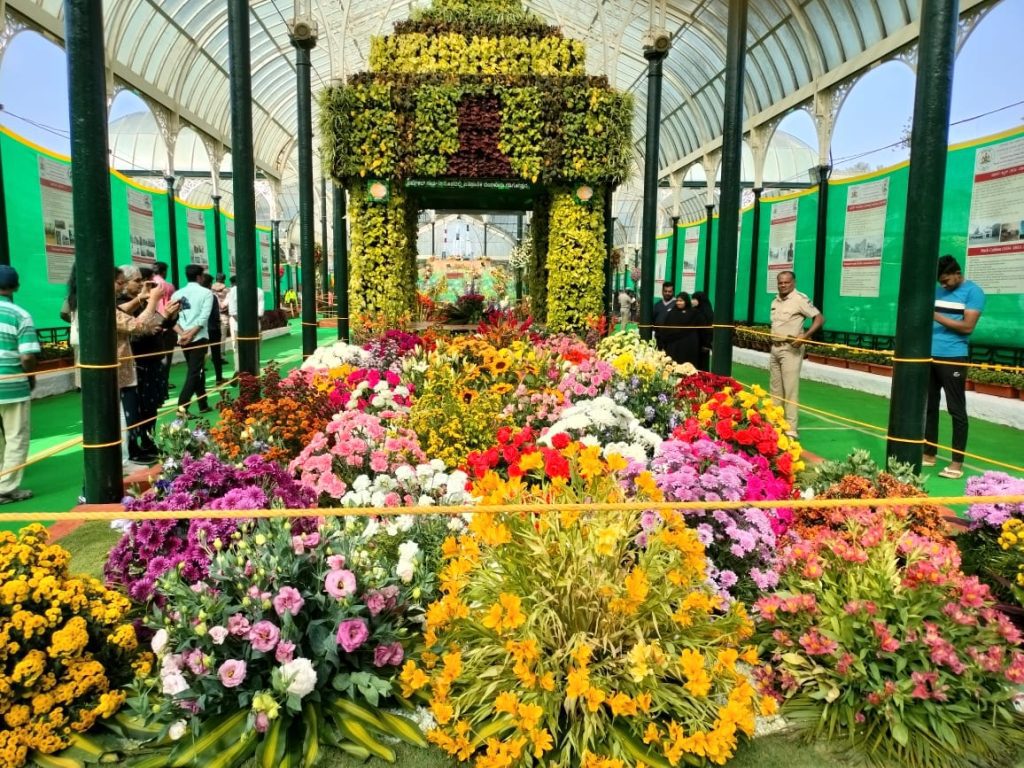
A Flower Riot at the 2023 Show
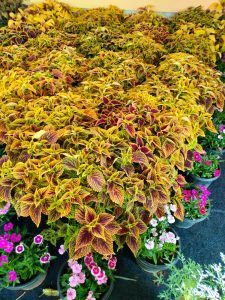
There’s a spring in the steps of the visitors and a festive air hangs over the 213th edition of Bengaluru’s annual flower show being held in the premises of the sprawling 240 acre garden to celebrate Republic Day. This show is expected to continue till January 29.
The main show is focussed largely inside the Glass House, and the primary attraction is a flower bed of chrysanthemums arranged in the shape of a waterfall, flowers of every possible kind and colour circle the centrepiece – anthuriums, gerbera, tulips, poinsettias, bird of paradises, heliconia, marigold, celosia, cox comb, dahlias, dianthus, sunflower, roses, orchids, begonias, daylilies, hydrangea and petunias.
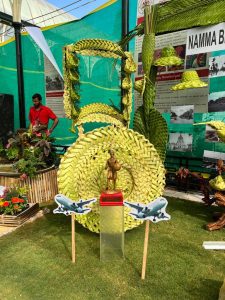
The cymbidiums from Darjeeling, ornamental pot-grown flowers from Pune, flowers from the cool climes of Ooty, exotic flowers like calla lily and painstakingly crafted ikebana displays are a sight for tech-soaked eyes.
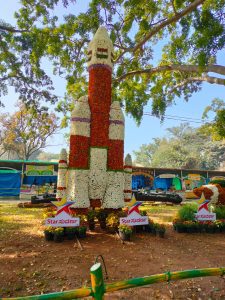
The organisers had used three lakh flower pots of 97 varieties on display, including 20 exotic flowers from different countries, says a statement from the organisers.
Besides the flower show, Lalbagh garden itself situated in the heart of the tech city of Bengaluru, and largely ignored by its busy residents, teems with fascinating stories from the past. One such story is that of GH Krumbiegal.
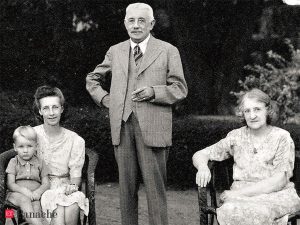
Krumbiegal’s story
More than 130 years ago, a young German landscape gardener set sail from England to travel to a far-away kingdom of Baroda to work for an Indian maharajah. It must have been an exotic and “extraordinary experience” for this German from Dresden, (which was famous for its garden architecture and a land embellishment movement) to move his family to a country he knew little about.
But the 28-year-old adventurous Gustav Hermann Krumbiegel, working in the plant propagation department in England’s celebrated Kew Gardens, took this ‘ticket to paradise’ and landed in Baroda as the curator of the state gardens of Maharaja Sayaji Rao Gaekwad III. This was in 1891-92, but Krumbiegel went on to firmly plant his roots in India, especially in Bengaluru’s Lalbagh park and botanical garden, (which he had joined in 1908 as a curator and stayed on till 1932 when he retired as director of horticulture ).
Gaekwad generously lent him to other Indian Maharajahs, and Krumbiegel is known to have beautified many a royal garden with flowering and fruity trees, and “landscaped his way through the country”. This landscape designer, horticulturist, town planner and a “flower maniac” is credited for giving Bangalore the sobriquet of Garden City through his concept of ‘serial blossoming’ or planting different flowering trees to ensure there are flowers blooming in the city all the year around.
Many of the lines and clusters of cassias, gulmohurs, tabebuias, which still adorn the streets of Bengaluru stem from Krumbiegel’s dreams of a colourful, flowering city.
On Krumbeigal’s significant contributions to Karnataka, Vijay Thiruvady, author of the book Lalbagh: From Sultan Garden to Public Park, published by Bangalore Environment Trust, tells The Federal: “Lalbagh was his headquarters. He did many things but some of his significant contributions were to bring 108 different of fruit bearing trees such as jamuns, pears, apples, strawberry, pomegranates, etc., from Australia, raspberry from Paris. Further, he would write two-line description of each plant and send it out to farmers and sold it to them for anywhere from 4 annas to 12 annas. Farmers had to indicate how many saplings they needed and he would get them shipped to Lalbagh from abroad. He would then pack it and send it to the farmer, he did a great service to the farmers of Karnataka.”
But it was not just Bengaluru, Krumbeigal was also involved in the design of Brindavan Gardens in Mysore, the Kowdiar Palace in Thiruvananthapuram, and was practically Bangalore’s first architect but sadly, he died a pauper in the country he had adopted as his own. (That’s another story)
This story of this “German sahib” has been captured in a documentary, The Maharaja’s German Gardener as well. In Jayaram’s Lalbagh book, he writes that Krumbiegal was not just an expert landscapist, he had also popularised economic botany, i.e., he had introduced plants that yielded industrial products such as gums, dyes, fibres, resins, aromatic oils, tiber, rubber and “acclimatised them to the native soil”.
Adds Jayaram, who has produced a book, GH Krumbiegel: Whatever he touched, he adorned, Krumbiegal introduced serial blossoming in the city and curated flowering trees in such a way that one or the other was in bloom through the year. That is one of his most key contributions to Bengaluru city itself.
Why Lalbagh matters
Besides Krumbiegal, whose story fascinates every time it is told, Lalbagh, which also boasts a prominent 3.5 billion-year old rock formation, has trees planted by Tipu Sultan, which still stand tall in the garden. In a chat with The Federal, Jayaram says, “Tipu brought plants particularly from French and Muslim territories which he had access to. Plants from East Africa, Madascagar, Mauritius, oaks and pines from Cape town and eucalyptus trees from Australia.”
While Vijay Thiruvady says, “As an act of piety, to thank his makers, Hyder Ali, established three gardens. One of them was Lalbagh. To Muslims, a garden on earth is a reflection of paradise, their approach to designing the garden was all important, their whole approach was almost like a sacred act.” Stemming from this act of piety, Lalbagh continues to thrive as a “jewel’ in this bustling, traffic-clogged Bengaluru city, holding within it many rich stories from the past.

